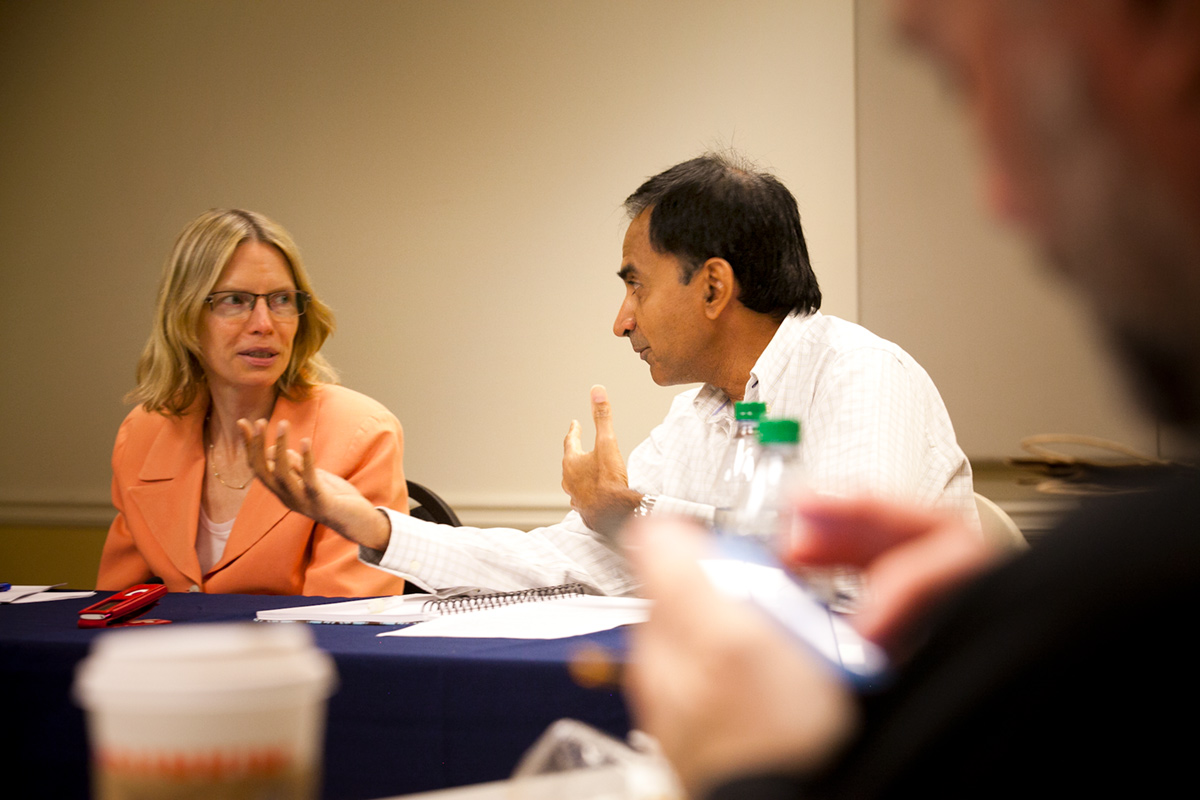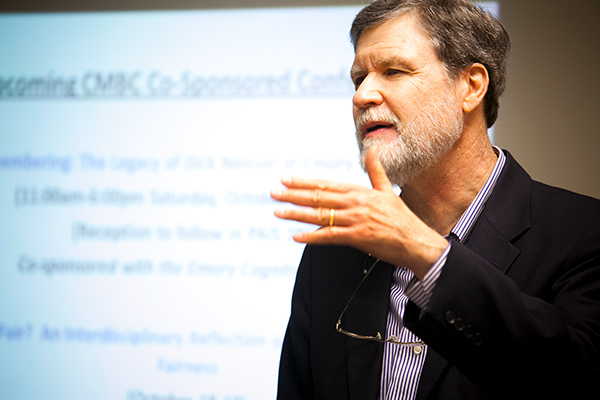Thoughts about Thought
Center cultivates research connections around human thinking and cognition

Kay Hinton
Close your eyes and picture a bridge. What does it look like?

Robert McCauley pitches a future topic: fairness.
Kay Hinton
A faculty member sees a covered bridge on a river; a graduate student sees a suspension bridge; virtually every answer is different. How we construct and process mental imagery is the topic of discussion led by Laura Otis, professor of English, and Krish Sathian, professor of neurology, at a recent lunchtime gathering.
These professors, who cotaught a course last year on metaphors, images, and the brain, have delved deep into the cognitive and chemical processes that produce the pictures in our heads. Although mental imagery is a unique experience, there are patterns that can tell us about how the mind works—for instance, some people think in objects, while others think more in terms of spatial relationships. “We tend to presume our mental experience is the same as others’, ” said Otis, who is working on a book based on interviews about what people envision when they read fiction. “But cognitive style is highly individual and can change over a lifetime.”
And everyone’s brain constructs some sort of mental imagery—even those who insist that they don’t see things in their minds.
This popular lunch series is one of the signature programs of the Center for Mind, Brain, and Culture (CMBC), a scholarly experiment celebrating its fifth anniversary this year. As one might gather from its name, the center’s figurative doors are thrown open to a fairly sweeping range of subjects—with one critical common denominator.
“Our target interests stretch from the brain to culture, with the mind, arguably, in between. It’s a lot of territory,” allows center director Robert McCauley, William Rand Kenan Jr. University Professor of Psychology. “But our focus is on the human.”
Led by McCauley and associate director Laura Namy, also a psychologist, the center has some 260 affiliates among Emory faculty, students, and alumni. Loosely defined by the study of what is human, the CMBC prioritizes projects that take a scientific approach, although that’s not a hard-and-fast rule. Its primary role is to showcase research and teaching by bridging disciplines—which is how a neurologist and an English professor wound up trading ideas over sandwiches.
“The notion of teaming people up has been incredibly successful,” McCauley says. “We have had to limit attendance to twenty people, and they always fill up. In a few cases the faculty members did not even know each other beforehand, so new connections are formed.”
Todd Preuss, a neuroscientist based at Yerkes National Primate Research Center, has been an active player in the center from the beginning. “The CMBC is really the main forum for talking about big ideas in human nature,” he says. “It’s an umbrella for people from very different disciplines who would not normally interact to interact, and I think it’s unique to Emory. ”
Preuss, an anthropologist by training, has participated in two of the center’s public colloquia on human evolution. The center also offers lectures, summer workshops, and sponsored seminars: semester-long courses that, ideally, are team taught by faculty from different areas, which “tends to lead to some fairly fertile interdisciplinary exchange,” McCauley says. Many of the students who take those courses are pursuing a certificate through the CMBC.
“I have deepened my knowledge about the philosophy of science, which I have incorporated into my own research,” says graduate student Kristina Gupta. “The center helped me to arrange a directed reading with Dr. Kim Wallen on the behavioral-neuroendocrinology of sex. That enabled me, as a scholar in the humanities, to become more familiar with scientific research on the topic and also allowed me to develop relationships with scientists in the field. I have presented the paper I wrote for Dr. Wallen at two conferences. I will take the interest in social studies of science and the commitment to interdisciplinary research and teaching that were fostered by the center with me as I progress in my career.”





